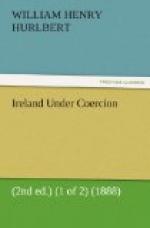The position of the Archbishop, both as a churchman and as a citizen, was impregnable. When Dr. M’Glynn advocated the plan of Henry George, he advocated at one and the same time the immoral seizure and confiscation of the whole income of many persons within the protection of the Constitution of New York, and the overthrow of the Constitution of that State and of the United States. It may be within the competency of the British Parliament to enact such a confiscation of rent without a revolution, there being not only no allodial tenure of land in Great Britain, but, it would appear, no limit to the power of a British Parliament over the lives, liberties, and property of British subjects, but the will of its members. But it is not within the competency of the Congress of the United States, or of the Assembly of New York, to do such a thing, the powers of these bodies being controlled and denned by written Constitutions, which can only be altered or amended in a prescribed manner and through prescribed and elaborate forms.
VII.
By the middle of October 1886 it became clear that Mr. George, whose candidacy had at first been regarded with indifference by the party managers, both Democratic and Republican, in New York, would command a vote certainly larger than that of one of these parties, and possibly larger than that of either of them. To put him at the head of a poll of three parties would elect him. This was so apparent that he and his friends, including Dr. M’Glynn and Mr. Davitt, were warranted in expecting a victory.
It was hardly therefore by a mere coincidence that this precise time was selected for opening the war in Ireland against Rent. It is quite possible that if Mr. Dillon and his Parliamentary friends had been in less of a hurry to open this war before the return of Mr. Davitt from America, it might have been opened in a manner less “politically stupid,” if not less “morally wrong.” But, of course, if Mr. Henry George had been elected Mayor of New York, as he came so near to being in November 1886, and Mr. Davitt had returned to Ireland with the prestige of contributing to place him in the municipal chair of the most important city in the New World, Mr. Dillon and his Parliamentary friends would probably have found it necessary to accept a much less conspicuous part in the conduct of the campaign.




